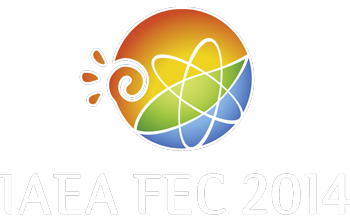Speaker
Dr
Boyd Blackwell
(Australian National University)
Description
The H-1 flexible heliac with its wide range of magnetic configurations is an ideal device for studying instabilities in the low to mid Alfvenic range – low to hundreds of kHz, in H/He RF-produced plasma around 0.5T. More than 80 magnetic probes in three arrays, and several optical imaging diagnostics provide data on poloidal, helical and radial mode structures. Sensitive multi channel interferometry, framing cameras synchronised with the mode, and gas puff illumination techniques provide density fluctuation data in two dimensions. The vast data set acquired shows very clear dependences on transform and density, made possible by the low shear and precise control of configuration. Electron density fluctuation profiles from a new, high sensitivity 21 chord interferometer, will be compared with tomographically inverted fluctuation mode structures from synchronously acquired images of CII impurity line emission. Mode structure and dispersion data are compared with predictions of several codes, notably CAS3D, and CONTI, and show both Alfvenic GAE-like and/or acoustic-like (BAE) behaviour in different regimes. Scaling with magnetic field and mass density will be compared with expectations for Alfvenic and GAM and other modes.
| Country or International Organisation | Australia |
|---|---|
| Paper Number | EX/P4-24 |
Author
Dr
Boyd Blackwell
(Australian National University)
Co-authors
Mr
Alexander Thorman
(Australian National University)
Dr
Axel Koenies
(Max-Planck-Institut für Plasmaphysik, Greifswald)
Dr
Carolin Nuehrenberg
(Max-Planck-Institut für Plasmaphysik, Greifswald)
Dr
David Pretty
(Australian National University)
Dr
Jason Bertram
(Australian National University)
Prof.
John Howard
(Australian National University)
Dr
Matthew John Hole
(Australian National University)
Prof.
Robert Dewar
(Australian National University)
Mr
Shaun Haskey
(Australian National University)

